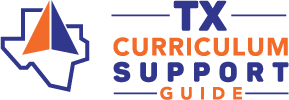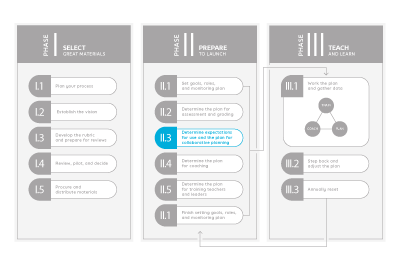What is the goal?
The goal of this key action is to set up the plans for pacing, use, and planning. This key action includes ensuring the right time is in the daily schedule and setting the expectations for materials use and customizations.
Why this key action is important
Instructional judgment (deciding what to teach and what to adapt) is fundamental to good curriculum implementation. Developers include more content than would be needed so that teachers have a range of material to meet their students’ needs. Having a strong starting point creates relief for teachers from the constant hunt for resources. However, it does not eliminate the work of preparing for instruction. Setting up clear plans for use and lesson preparation creates clarity about what needs to be taught and the specific role the materials need to play in instruction. Quality collaboration opportunities invigorate practice and strengthen implementation; however, these structures require clarity, support, and a clear plan of action. This key action begins with a curriculum study to help all decision makers deeply understand the intent and design of the materials. This understanding supports strong decision-making about material adaptations.
Key Actions II.3-II.5 focus on systems for teacher and leader support, or the system’s overall plan for supporting professional learning. These systems must work together so that teachers do not receive mixed messages about how to use the materials. These systems also depend on a strong instructional culture within the school and district/charter network.
Explanation of language
We do NOT use the word “fidelity” because we have found that it is often used as a blanket term to the whole curriculum—as opposed to identifying which aspects of the curriculum (i.e., assessments, units, lessons) should be taught in a common way, across the school or district/charter network. The schedule refers to the daily plan for time. Pacing refers to the instructional calendar across the school year. We use the term collaborative planning to refer to the planning work that teachers may do with other teachers using the same materials. We do NOT use the term “professional learning collaborative/community” or “PLC” throughout this step, although many schools will probably equate collaborative planning with PLCs. We focus instead on collaborative planning.
We define collaborative planning as “time teachers spend together to prepare for and reflect on instruction.”
There are three practices within the collaborative planning structure:
- Unit internalization:
-
- Unit internalization is the process by which teachers study a curriculum unit to deeply understand what students are expected to learn (the “big ideas”), how students will be assessed, and the arc of learning over the course of the unit. To address unfinished learning, teachers make adjustments to the timing of the unit and intentionally use pedagogical strategies to provide targeted support to specific students.
- Lesson preparation
- Lesson preparation is the process by which teachers study an upcoming lesson(s) to deeply understand what students are expected to learn and how students will be assessed. Teachers make adjustments to the lesson and use pedagogical content strategies to support the needs of specific students with a focus on unfinished learning.
- Student work analysis
- Student work analysis is the process of analyzing student work for two purposes: 1) to determine if the task is aligned to grade-level standards and 2) to inform instructional next steps based on the depth of student learning. By examining the work itself, teachers gain insight about what students understand in order to build off their knowledge in future lessons. This asset-based approach is also valuable for school leaders because, unlike standardized test results that take weeks to months to receive, it provides an immediate, timely view into student learning that can help inform instructional priorities and school improvement efforts.

